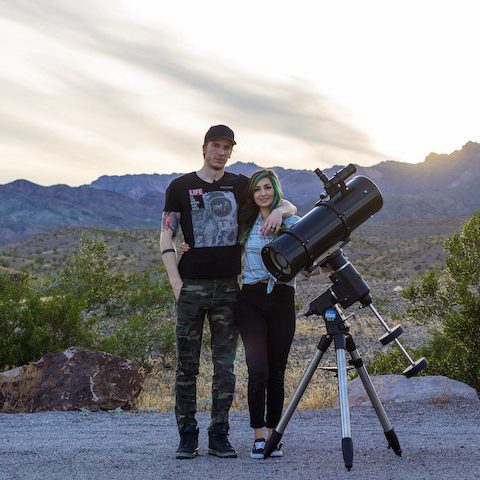By Michael Barber
For several decades monochrome CCDs were the sensor of choice for dedicated astro-imagers. Initially, CCDs were smaller in area than standard 35mm film frames but they were more sensitive and did not suffer from reciprocity failure, a common characteristic of film emulsions. However, CCDs were expensive and it took some time before 35mm sized sensors were available at prices that amateurs could afford. In the meantime, telescope optics capable of producing high resolution images over a large area continued to be improved. Eventually, around 2006, Kodak released two sensors designed for digital radiography, the KAF16803 and its cousin with larger pixels, the KAF-9000. Fortunately for amateur astronomers, these medium format sized monochrome sensors were priced more reasonably than their similarly sized predecessors and cameras with medium format CCDs could be made for astronomy that cost around $10,000 instead of $30,000 and more. The KAF16803 became highly desired for its 16 megapixel resolution and 36.8mm x 36.8mm image area. It remained the dream sensor for serious astro-imagers until only recently. Now, of course, it has been discontinued, along with most other commercially available CCDs that used to be of interest to amateur astronomers, falling victim to the many technological improvements in CMOS sensors that have pushed CMOS to the forefront of scientific imaging.
CMOS development followed a similar path as CCDs in size progression over time. Initially, CMOS were widely available in small sized sensors and gradually both quality and size increased until today Sony and other CMOS manufacturers fabricate large, scientific quality, high resolution CMOS sensors that surpass their CCD predecessors in nearly every way.
About 4 years ago, Sony released two, nearly identical, scientific CMOS sensors, the IMX411 and IMX461. The only significant difference between the two sensors was the pixel count. The IMX411 has the highest pixel count of any commercially available sensor, 151 Megapixels. It is still relatively expensive for amateurs and its large 54mm x 40mm image area also requires filters that are quite expensive when they can be found. However, the slightly smaller, 102 Megapixel, IMX461 is based on the same architecture as the 411 and its image area measures 44mm x 33mm, making it compatible with more commonly available and less expensive 50mm square filters. And, with the release of QHYCCD’s new photographic version QHY461-PH camera, the price is also now comparable to typical 16803 based cameras. This latest development makes the QHY461M-PH the ideal successor and updated replacement for serious imagers wanting an improved medium format camera to replace their aging, discontinued 16803 models.
The question then is how does the IMX461 sensor compare to the KAF16803? What are the advantages of the new IMX461 compared to the KAF16803?
| Specification | Typical 16803 Camera | QHY461 |
| Sensor | KAF16803 CCD | Sony IMX461 CMOS |
| Type | Front-Illuminated | Back-Illuminated |
| Pixel Size | 9um | 3.76um |
| Resolution | 4096 x 4096 | 11760 × 8896 |
| Total Pixels | 16 Megapixels | 102 Megapixels |
| Sensor Size (HxV) | 37mm x 37mm | 44mm x 33mm |
| Sensor Size Diagonal | 52mm | 55mm |
| Read Noise | 13e- | 1e- to 3.7e- |
| Dark Current | 0.05e-@-20C | 0.003e-@-20C |
| Quantum Efficiency at 450nm | 45% | 90% |
| Quantum Efficiency at 550nm | 60% | 83% |
| Quantum Efficiency at 650nm | 46% | 59% |
| A/D | 16-bit | 16-bit |
| Full well | 100ke- | 50ke-/80ke- |
| Dynamic Range | 1:7,700 | 1:13,500 |
| Full Frame Download @ 16-bits | 9 seconds per frame | 0.77 seconds per frame |
| User Selectable Read Modes | 1 | 4 |
SENSOR TYPE
The 16803 is a front-illuminated CCD while the IMX461 is a back-illuminated CMOS. The back-illuminated structure of the IMX461 has several advantages over a front illuminated sensor including higher quantum efficiency and greater full well capacity per square um allowing smaller pixels to have equal or greater sensitivity and dynamic range as their front-illuminated counterpart. Moreover the CMOS structure developed by Sony has much lower noise than just about any CCD (See A/D Section, below).
PIXEL SIZE AND RESOLUTION
Here the sensors are quite different. Whether we consider resolution just the ability to resolve detail or the number of pixels in an image, the IMX461 exceeds the 16803 by a significant margin. Ability to resolve detail is determined by the pixel size and the focal length. Many high quality fast wide field apochromatic refractors have the ability to illuminate a medium format sensor. High quality, short focal length refractors benefit from smaller pixels for highest resolution images. The IMX461 has over 6X the number of pixels as the KAF16803, 102 million vs. 16 million. Moreover, for large scopes, the 461 can be binned 2×2 to produce 7.5um pixels and still have an effective resolution of 25 Megapixels, still 56% more than the 16803.
SENSOR SIZE
The image at the top of this article shows the relative sizes of the two sensors. The IMX461 is 44mm x 33mm with a 55mm diagonal. The KAF16803 is 36.8mm x 36.8mm with a 52mm diagonal. So through a given optical system, they have nearly the same FOV with the 461 having a slightly larger image area.
READ NOISE
At lowest gain, the 461 achieves read noise as low as 3.7 electrons, about 3 times lower than the 16803. At high gain, the 461 read noise is a remarkable 1e-, 10 times lower than the 16803. Such low read noise in high gain mode makes it possible to take multiple shorter duration exposures and stack them to achieve results comparable to single long exposures. This requires less emphasis on tracking and allows selection of the best frames to compile into the final image. Since read noise is a fixed value per exposure, regardless of exposure time, shorter exposures benefit more from cameras with lower read noise.
DARK CURRENT
Unlike read noise, dark current increases with exposure time and can be a dominant source of noise as it accumulates in long exposures. At -20C the 461 has a dark current of 0.003 e-/pixel/second, about 16 times lower than the 16803 at the same temperature. Since dark current noise increases with exposure time, longer exposures benefit more from cameras with lower dark current. Therefore, images from a QHY461- PH contain far less noise than those from a 16803 whether taking short or long exposures
QUANTUM EFFICIENCY
The peak QE of the IMX461 is 1.5X higher than the 16803 (90% vs. 60%) and its spectral response is higher across the entire visible spectrum. The 461 is therefore not only much lower in read noise and dark current than a 16803 but also higher in sensitivity again, without compensating for pixel size.
A/D CONVERSION
Most 16803 based cameras were designed with a 16-bit A/D. The QHY461-PH also has 16-bit A/D. However, it is worth noting the different way these two sensors go about digitizing their signals. The 16803 is a full frame CCD. The term “full frame” is used here in the technical sense. (The same term is also often used to describe any sensor that is the same size as a full 35mm film frame but that is not the meaning when applied to the structure of a CCD.) A full frame CCD is simply a CCD in which the full frame of pixels receives light during an exposure. At the end of the exposure the CCD is usually covered by a mechanical shutter to stop light from reaching the pixels while the signal is processed. The charge that has accumulated in the pixels is first transferred vertically row by row to the last row. The last row is shifted horizontally pixel by pixel where each pixel’s charge is digitized passing through a single 16-bit A/D. Each time the charge is shifted there is some possibility of error creeping into the signal adding to the noise in the image.
In the IMX461, however, instead of all the pixels being processed by one A/D, each column of pixels has its own 16-bit A/D. Moreover, as the charge is being shifted down the column to the A/D, noise reduction is applied both before the A/D conversion and after the A/D conversion. This not only dramatically speeds up the readout process, it also dramatically reduces readout noise.
FULL WELL CAPACITY
Larger pixels produce greater full well but, even though the 461 has much smaller pixels than a 16803, it has a full well capacity of 50,000 electrons in standard mode and about 80,000 electrons in extended mode, unbinned. In binned modes, the 461 full well can be increased to as much as 320,000e- when binned 2×2 or 720,000e- when binned 3×3.
DYNAMIC RANGE
The dynamic range of a sensor is typically defined as the full-well capacity divided by the read noise and is an indication of a camera’s ability to capture very dim signals and bright signals in the same exposure. The read noise of a typical 16803 camera is around 13e- and the full well is 100,000. This gives us a dynamic range of about 1:7700. At lowest gain, the read noise of the QHY461-PH is 3.7e- and the full well is 50,000 in standard mode. This yields a dynamic range of 1:13,500, or about 1.75X greater than the 16803.
READ MODES
Generally, the read mode of a typical CCD camera is set by the camera’s designers and is not adjustable by the user. This is the case with the majority of 16803 based cameras. Sony, however, provides multiple read modes for the IMX461 and these are easily selectable by the user in software when the camera driver is loaded. One mode, for example, extends the full well capacity from 50,000e- to about 80,000e- with 1×1 binning. Otherwise, any one of the four read modes may be selected whenever the camera is connected to optimize the read noise, gain, full well and/or dynamic range for a particular type of imaging.
DOWNLOAD TIME / FRAME RATE
It is notable that in the specifications for typical 16803 based cameras, the time it takes for an image to download to the computer was normally defined as DOWNLOAD TIME and was normally expressed in seconds per frame. Now, however, with modern CMOS sensors this same specification is defined as FRAME RATE and is typically expressed in Frames Per Second. The rate at which the sensor is read out contributes to your productivity, particularly when taking multiple short exposures and certainly less frustration when focusing or centering an object. This image download rate for the 461 sensor is about 3/4 of a second for a full, 16-bit, 102 megapixel image. Compare this to about 10 seconds per frame for a 16803 camera using USB 2.
SUMMARY
The foregoing tells us that not only does the IMX461 outperform the 16803 in virtually every specification but also the ability of the QHY600 to adjust gain, read noise and full well to meet the demands of a variety of imaging situations makes the camera a more flexible instrument as well.
More information about QHY461PH: https://www.qhyccd.com/qhy461ph/


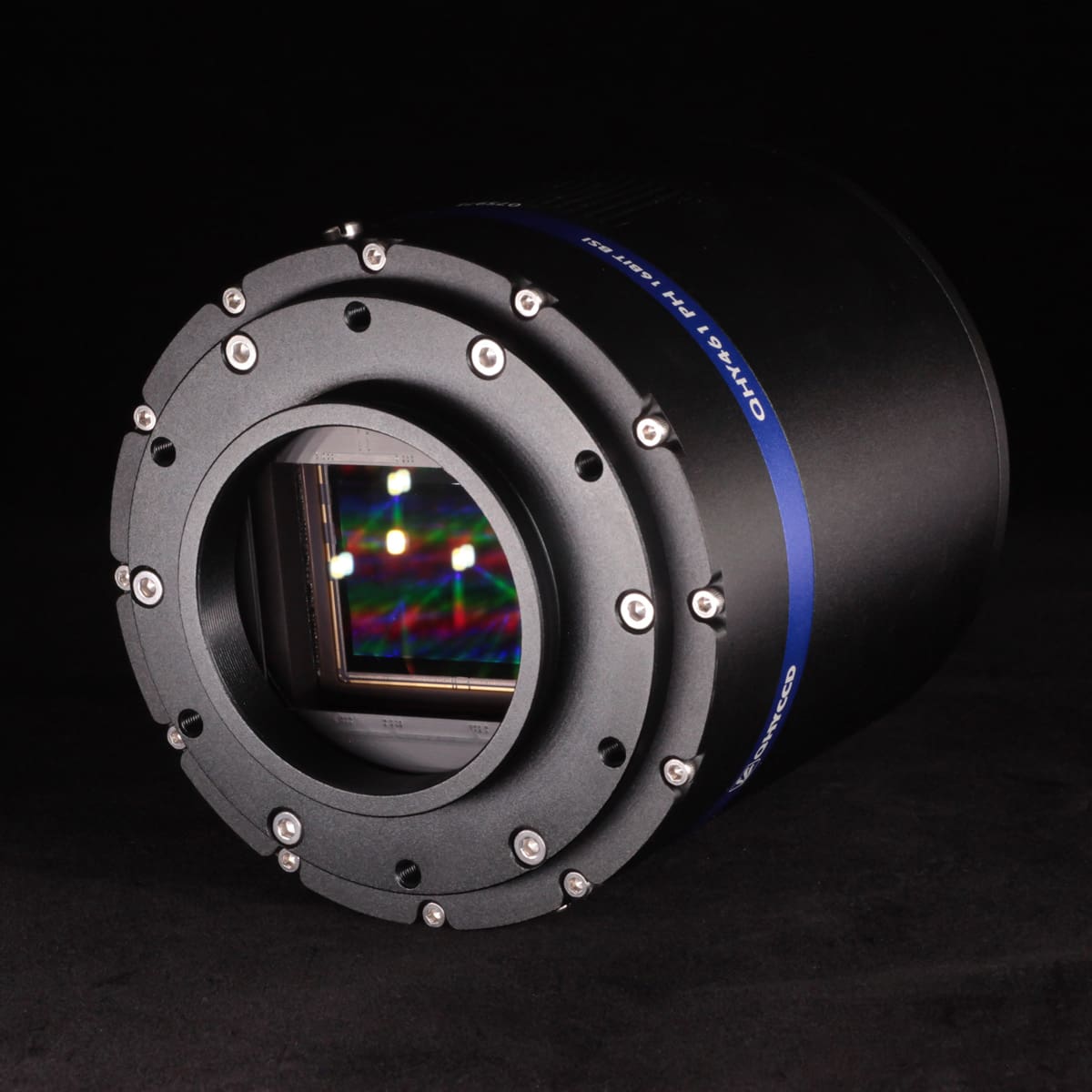
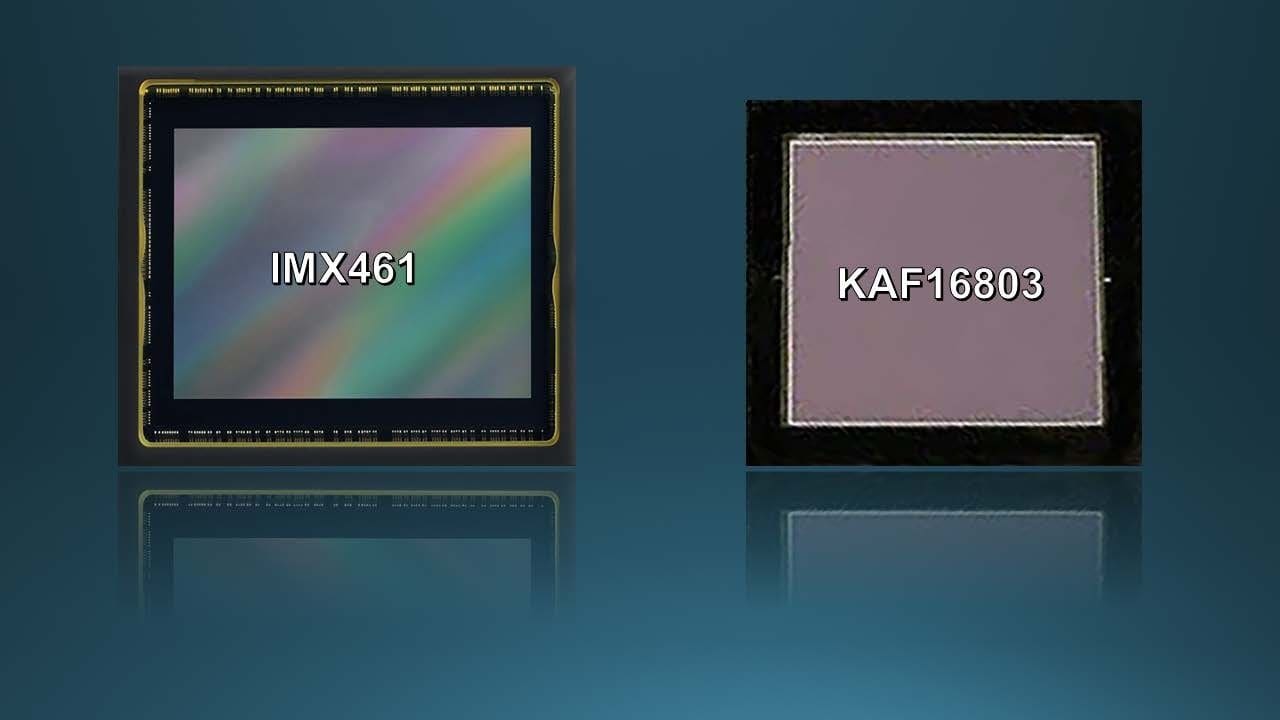
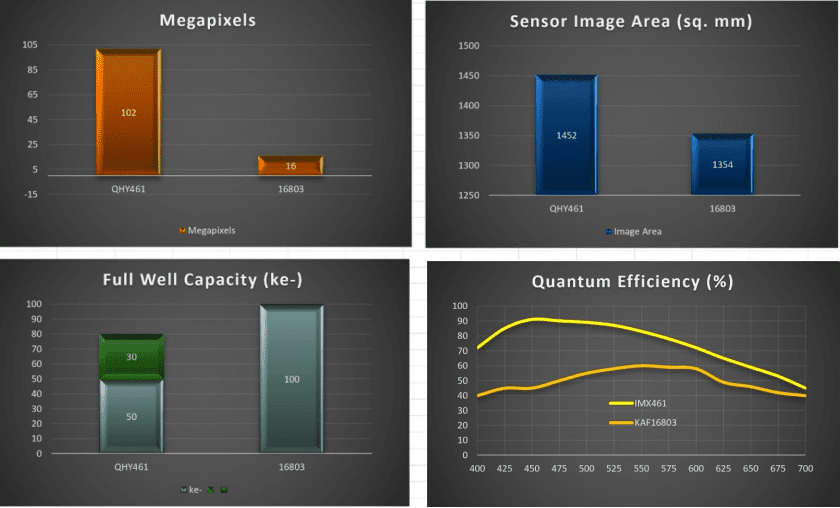
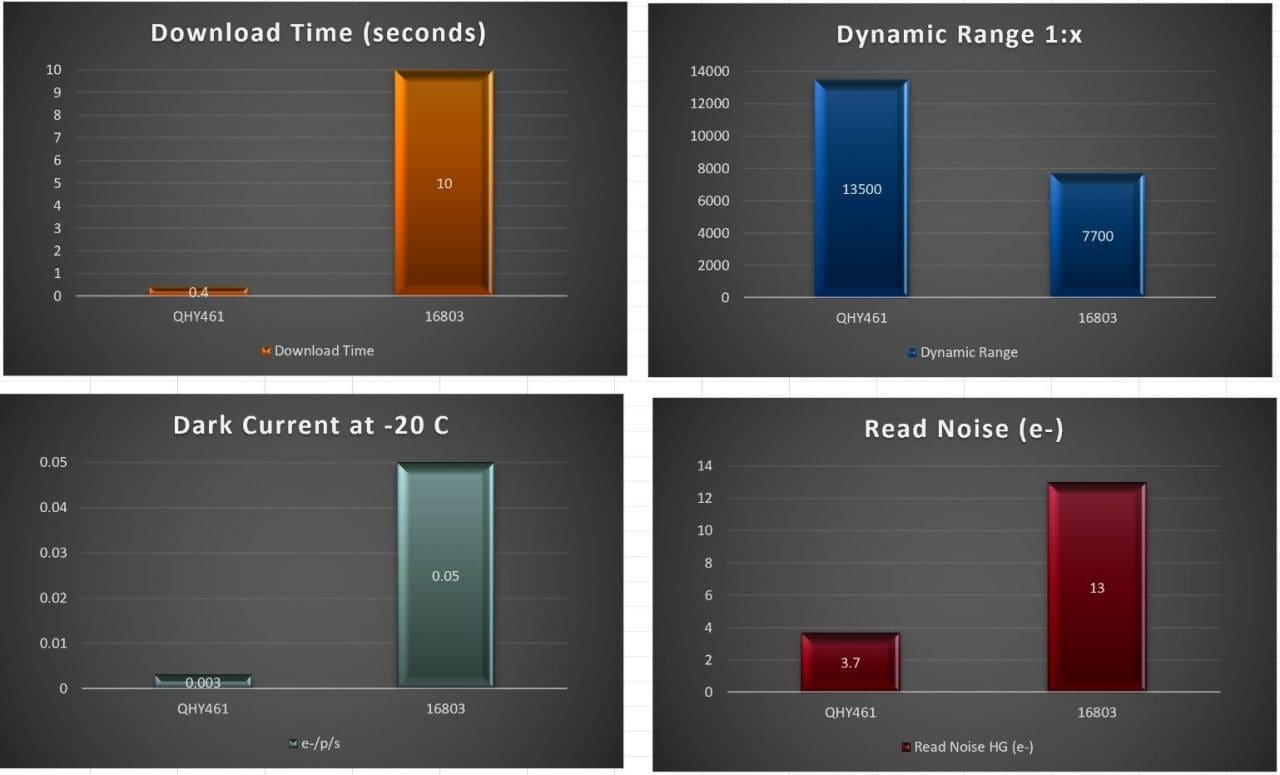
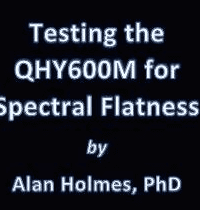
![[User’s Interview] Kevin Morefield’s Astrophotography Story](https://www.qhyccd.com/wp-content/uploads/20220907400-scaled.jpeg)
